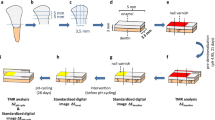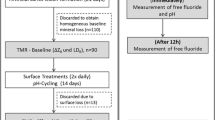Abstract
Objectives
This double-blind, crossover, and in situ study evaluated the effect of commercial high-F toothpastes with or without functionalized β-tri-calcium phosphate (fTCP) and conventional-F toothpaste containing or not 1.5% arginine-CaCO3 in preventing and repairing root caries-like lesions.
Methods
Twelve volunteers wore palatal appliances containing sound (S) and pre-demineralized (PD) bovine root dentin blocks in 4 phases of 14 days/each. They used F toothpastes, 3×/day: (i) 1,450 μg F/g (conventional-F); (ii) 1,450 μg F/g + 1.5% arginine-CaCO3 (conventional-F + arginine/CaCO3); (iii) 5,000 μg F/g (high-F); and (iv) 5,000 μg F/g (high-F + fTCP). Sucrose solution (20%) was dropped 8×/day on the S blocks. The demineralization in the S blocks and the remineralization in the PD ones were estimated by % of surface hardness difference (%SH-S) and % of SH recovery (%SHR-PD), respectively. Caries lesion area (ΔS) was determined in the blocks. Statistical analyses were performed by one-way ANOVA/Kruskal-Wallis and multiple comparisons tests (p < 0.05).
Results
Both high-F toothpastes presented similar effect to prevent early caries lesions and it was higher than conventional-F + arginine/CaCO3. All treatments resulted in significantly lower ΔS values compared with conventional-F toothpaste (p < 0.0001). High-F + fTCP showed non-significantly higher preventive and reversible effect compared to high-F. The effect of conventional-F + arginine/CaCO3 was similar to high-F and lower than high-F + fTCP in preventing and reverting in-deep caries lesions.
Conclusions
Overall, high-F toothpastes seem to be more effective and interesting feasible strategy for both prevention and remineralization actions in root dentin.
Clinical relevance
With the trend of increasing dentin root caries, this study brings new evidences about the preventive and repair effect of high-F toothpastes with or without fTCP in root caries and support the use of arginine in toothpastes.



Similar content being viewed by others
References
World Health Organization (WHO) (2011) What are the public health implications of global ageing?http://www.who.int/features/qa/42/en/ 2011 (accessed 13 May 2018)
Takahashi N, Nyvad B (2016) Ecological hypothesis of dentin and root caries. Caries Res 50:422–431
Baysan A, Lynch E, Ellwood R, Davies R, Petersson L, Borsboom P (2001) Reversal of primary root caries using dentifrices containing 5,000 and 1,100 ppm fluoride. Caries Res 35:41–46
Ravald N, Hamp SE, Birkhed D (1986) Long-term evaluation of root surface caries in periodontally treated patients. J Clin Periodontol 13:758–767
Clarkson JE (1995) Epidemiology of root caries. Am J Dent 8:329–334
Campos Velo MMA, Farha ALH, da Silva Santos PS, Shiota A, Sansavino SZ, Souza ATF, Honório HM, Wang L (2017) Gamma radiation increases the risk of radiation-related root dental caries. Oral Oncol 71:184–185
Velo MMAC, Farha ALH, da Silva Santos PS, Shiota A, Sansavino SZ, Souza AT, Honório HM, Wang L (2018) Radiotherapy alters the composition, structural and mechanical properties of root dentin in vitro. Clin Oral Investig 22:2871–2878
Galan D, Lynch E (1994) Prevention of root caries in older adults. J Can Dent Assoc 60:422–433
Tan H, Richards L, Walsh T, Worthington HV, Clarkson JE, Wang L, Mattar de Amoedo Campos Velo M (2017) Interventions for managing root caries (Protocol). Cochrane Database of Systematic Reviews, Issue 8. Art. No.: CD012750. https://doi.org/10.1002/14651858.CD012750
Rølla G, Ogaard B, Cruz RA (1991) Clinical effect and mechanism of cariostatic action of fluoride containing toothpastes: a review. Int Dent J 11:442–447
Marinho VC, Higgins JP, Logan S, Sheiham A (2003) Fluoride toothpastes for preventing dental caries in children and adolescents. Cochrane database Syst. Rev in: the Cochrane library, issue 1
Lippert F (2013) An introduction to toothpaste - its purpose, history and ingredients. Monogr Oral Sci 23:1–14
Walsh T, Worthington HV, Glenny AM, Appelbe P, Marinho VC, Shi X (2010) Fluoride toothpastes of different concentrations for preventing dental caries in children and adolescents. Cochrane Database Syst Ver:CD007868. https://doi.org/10.1002/14651858.CD007868
Velo MM, Tabchoury CP, Romão DA, Cury JA (2016) Evaluation of low fluoride toothpaste using primary enamel and a validated pH-cycling model. Int J Paediatr Dent 26:439–447
Ekstrand KR (2016) High fluoride dentifrices for elderly and vulnerable adults: does it work and if so, then why? Caries Res 50(Suppl 1):15–21
Wierichs RJ, Meyer-Lueckel H (2015) Systematic review on noninvasive treatment of root caries lesions. J Dent Res 94:261–271
Karlinsey RL, MacKey AC, Walker ER, Frederick KE (2010) Surfactant-modified 훽-TCP: structure, properties, and in vitro remineralization of subsurface enamel lesions. J Mat Sci 21:2009–2020
Karlinsey RL, Pfarrer AM (2012) Fluoride plus functionalized b-TCP: a promising combination for robust remineralization. Adv Dent Res 24:48–52
Wierichs RJ, Stausberg S, Lausch J, Meyer-Lueckel H, Esteves-Oliveira M (2018) Caries-preventive effect of NaF, NaF plus TCP, NaF plus CPP-ACP, and SDF varnishes on sound dentin and artificial dentin caries in vitro. Caries Res 52:199–211
Cummins D (2013) The development and validation of a new technology, based upon 1.5% arginine, an insoluble calcium compound and fluoride, for everyday use in the prevention and treatment of dental caries. J Dent 41:S1–S11
Cummins D (2016) The superior anti-caries efficacy of fluoride toothpaste containing 1.5% arginine. J Clin Dent 27:27–38
Wijeyeweera RL, Kleinberg I (1989) Arginolytic and ureolytic activities of pure cultures of human oral bacteria and their effects on the pH response of salivary sediment and dental plaque in vitro. Arch Oral Biol 34:43–53
Ástvaldsdóttir Á, Naimi-Akbar A, Davidson T et al (2016) Arginine and caries prevention: a systematic review. Caries Res 50:383–393
Buchalla W, Attin T, Roth P, Hellwig E (2003) Influence of olive oil emulsions on dentin demineralization in vitro. Caries Res 37:100–107
Amaechi BT, Higham SM, Edgar WM (1998) Efficacy of sterilisation methods and their effect on enamel demineralization. Caries Res 32:441–446
Comar LP, Wiegand A, Moron BM, Rios D, Buzalaf MA, Buchalla W, Magalhães AC (2012) In situ effect of sodium fluoride or titanium tetrafluoride varnish and solution on carious demineralization of enamel. Eur J Oral Sci 120:342–348
Nóbrega DF, Fernández CE, Del Bel Cury AA, Tenuta LM, Cury JA (2016) Frequency of fluoride dentifrice use and caries lesions inhibition and repair. Caries Res 50:133–140
Vale GC, Tabchoury CP, Del Bel Cury AA, Tenuta LM, ten Cate JM, Cury JA (2011) APF and dentifrice effect on root dentin demineralization and biofilm. J Dent Res 90:77–81
Moron BM, Comar LP, Wiegand A, Buchalla W, Yu H, Buzalaf MA, Magalhães AC (2013) Different protocols to produce artificial dentine carious lesions in vitro and in situ: hardness and mineral content correlation. Caries Res 47:162–170
Angmar B, Carlstrom D, Glas JE (1963) Studies on the ultrastructure of dental enamel. IV The mineralization of normal human enamel J Ultrastruct Res 8:12–23
Hayes M, Da Mata C, Cole M, McKenna G, Burke F, Allen PF (2016) Risk indicators associated with root caries in independently living older adults. J Dent 51:8–14
Pentapati KC, Siddiq H, Yeturu SK (2019) Global and regional estimates of the prevalence of root caries - systematic review and meta-analysis. Saudi Dent J 31:3–15
Paiva MF, Delbem ACB, Danelon M et al (2017) Fluoride concentration and amount of dentifrice influence enamel demineralization in situ. J Dent 66:18–22
Zero DT (1995) In situ caries models. Adv Dent Res 9:214–230
Featherstone JD (2000) The science and practice of caries prevention. J Am Dent Assoc 131:887–899
Hicks J, Garcia-Godoy F, Flaitz C (2004) Biological factors in dental caries: role of remineralization and fluoride in the dynamic process of demineralization and remineralization (part 3). J Clin Pediatr Dent 28:203–214
Buzalaf MA, Pessan JP, Honório HM, ten Cate JM (2011) Mechanisms of action of fluoride for caries control. Monogr Oral Sci 22:97–114
ten Cate JM (1997) Review on fluoride, with special emphasis on calcium fluoride mechanisms in caries prevention. Eur J Oral Sci 105:461–465
Tenuta LM, Cury JA (2013) Laboratory and human studies to estimate anticaries efficacy of fluoride toothpastes. Monogr Oral Sci 23:108–124
Velo MMAC, Magalhães AC, Shiota A, Farha ALH, Grizzo LT, Honório HM, Wang L (2018) Profile of high-fluoride toothpastes combined or not with functionalized tri-calcium phosphate on root dentin caries control: an in vitro study. Am J Dent 31:290–296
Mohd Said SN, Ekambaram M, Yiu CK (2017) Effect of different fluoride varnishes on remineralization of artificial enamel carious lesions. Int J Paediatr Dent 27:163–173
Karlinsey RL, Mackey AC, Walker TJ, Frederick KE, Blanken DD, Flaig SM, Walker ER (2011) In vitro remineralization of human and bovine white-spot enamel lesions by NaF dentifrices: a pilot study. J Dent Oral Hyg 3(2):22–29
Philip N (2019) State of the art enamel Remineralization systems: the next frontier in caries management. Caries Res 53:284–295
Christoffersen J, Christoffersen MR, Kibalczyc W, Perdok WG (1988) Kinetics of dissolution and growth of calcium fluoride and effects of phosphate. Acta Odontol Scand 46:325–336
Cochrane NJ, Shen P, Yuan Y, Reynolds EC (2014) Ion release from calcium and fluoride containing dental varnishes. Aust Dent J 59:100–105
Hattab FN (2013) Remineralisation of carious lesions and fluoride uptake by enamel exposed to various fluoride dentifrices in vitro. Oral Health Prev Dent 11:281–290
Shen P, Walker GD, Yuan Y, Reynolds C, Stanton DP, Fernando JR, Reynolds EC (2018) Importance of bioavailable calcium in fluoride dentifrices for enamel remineralization. J Dent 78:59–64
Balakrishnan A, Jonathan R, Benin P, Kuumar A (2013) Evaluation to determine the caries remineralization potential of three dentifrices: an in vitro study. J Conserv Dent 16:375–379
Bijle MNA, Ekambaram M, Lo EC, Yiu CKY (2018) The combined enamel remineralization potential of arginine and fluoride toothpaste. J Dent 76:75–82
Souza ML, Cury JA, Tenuta LM et al (2013) Comparing the efficacy of a dentifrice containing 1.5% arginine and 1450 ppm fluoride to a dentifrice containing 1450 ppm fluoride alone in the management of primary root caries. J Dent 41:S35–S41
Bradshaw DJ, Marsh PD, Watson GK, Allison C (1998) Role of Fusobacterium nucleatum and coaggregation in anaerobe survival in planktonic and biofilm oral microbial communities during aeration. Infect Immun 66:4729–4732
Reyes E, Martin J, Moncada G et al Caries-free subjects have high levels of urease and arginine deiminase activity. J Appl Oral Sci 22:235–240
Cheng X, Xu P, Zhou X et al (2015) Arginine promotes fluoride uptake into artificial carious lesions in vitro. Aust Dent J 60:104–111
Grandjean P, Landrigan PJ (2014) Neurobehavioural effects of developmental toxicity. Lancet Neurol 13:330–338
Lynch RJ, Smith SR (2012) Remineralization agents - new and effective or just marketing hype? Adv Dent Res 24:63–67
Acknowledgments
We thank FAPESP (São Paulo Research Foundation) for the concession of a scholarship to the first author (Proc. 2015/00817-2) and for the microradiography analyses (grant no. 2009/53849-8). The authors thank the volunteers for their participation, Audria Veronez for their technical support during the study and Leonardo Ceregatti for the support with statistical analysis. We are also grateful to Ms. Larissa Tercilia Grizzo, for technical assistance.
Funding
This work was supported by FAPESP (São Paulo Research Foundation) (Proc. 2015/00817-2).
Author information
Authors and Affiliations
Corresponding author
Ethics declarations
Conflict of interest
The authors declare that they have no conflict of interest.
Ethical approval
This study has been approved by the local research ethics committee. All procedures performed in this study involving human volunteers were in accordance with the ethical standards of the institutional and/or national research committee and with the 1964 Helsinki declaration and its later amendments or comparable ethical standards.
Informed consent
Informed consent was obtained from all individual participants included in the study.
Additional information
Publisher’s note
Springer Nature remains neutral with regard to jurisdictional claims in published maps and institutional affiliations.
Rights and permissions
About this article
Cite this article
de Amoêdo Campos Velo, M.M., Agulhari, M.A.S., Rios, D. et al. Root caries lesions inhibition and repair using commercial high-fluoride toothpastes with or without tri-calcium phosphate and conventional toothpastes containing or not 1.5% arginine CaCO3: an in situ investigation. Clin Oral Invest 24, 2295–2304 (2020). https://doi.org/10.1007/s00784-019-03084-8
Received:
Accepted:
Published:
Issue Date:
DOI: https://doi.org/10.1007/s00784-019-03084-8




